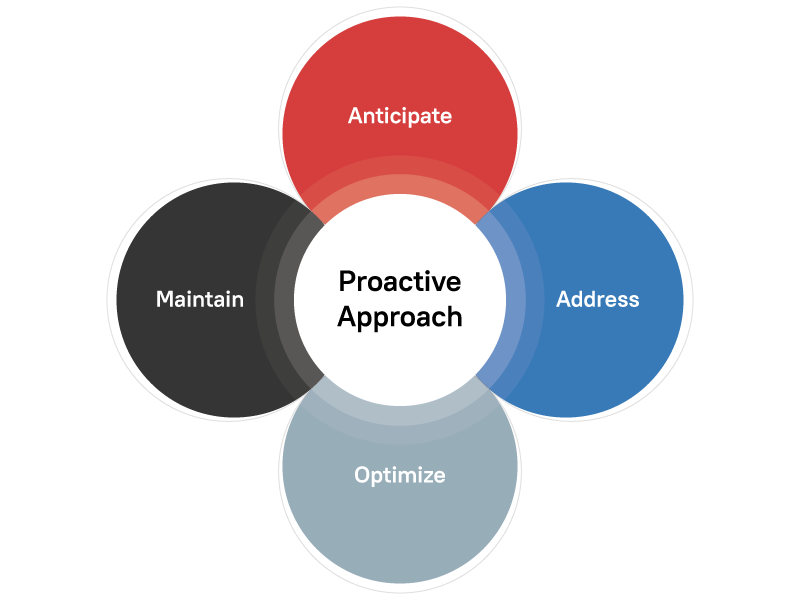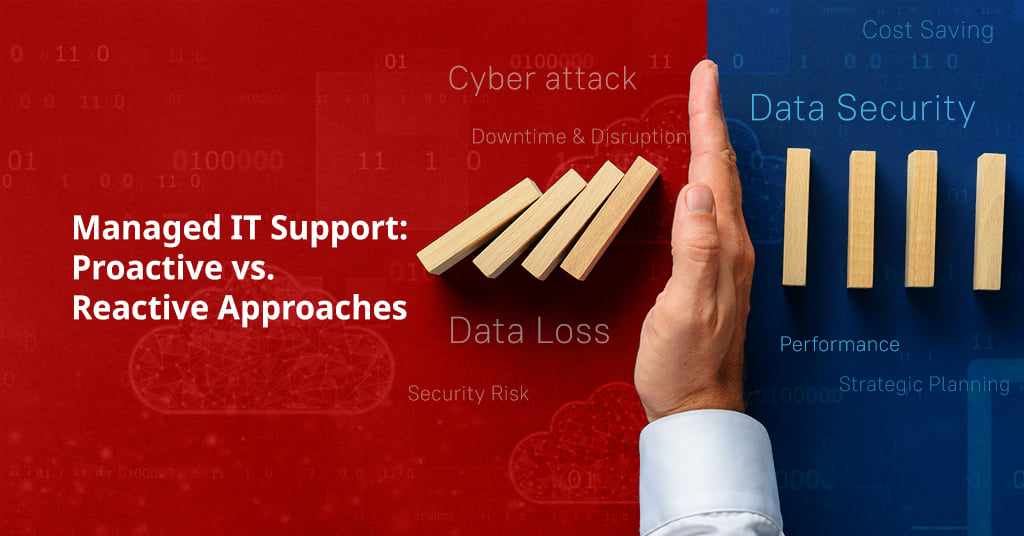When it comes to proactive vs. reactive approaches for problem-solving in managed IT, business owners and operators must understand the implications of both methods.
The choice between a proactive and reactive approach holds significant implications for the efficiency, stability, and security of a business’s technical infrastructure. Both represent distinct models that impact how IT issues are handled. Thus, understanding the differences between a proactive and reactive approach is central to making informed decisions that align with your business’s unique goals and needs.
Proactive Approach in Managed IT | Reactive Approach in Managed IT |
| The proactive approach, much like its name suggests, involves a forward-looking strategy that prioritizes preventing IT issues before they can cause disruptions. | The reactive approach involves addressing technology issues as they arise, often in response to disruptions or failures. |
| Continuous monitoring, regular system maintenance, and pre-emptive actions to identify vulnerabilities and implement security measures characterize this approach. | With this approach, IT teams react to problems after they have impacted the system, leading to potential downtime, decreased productivity, and higher costs associated with emergency repairs. |
Proactive vs. Reactive Approach: Which One to Choose?
The proactive approach helps optimize performance by staying ahead of potential problems.
On the other hand, while the reactive approach can manage immediate issues, it lacks the foresight and preventative measures that the proactive approach offers, which makes it less efficient for maintaining a stable and optimized IT infrastructure over the long term.
Let’s look at the difference between proactive and reactive approaches in some detail below.
Key Benefits: Proactive Approach

- Pre-emptive Measures: The proactive IT approach focuses on identifying and addressing vulnerabilities early on, thereby reducing the likelihood of security breaches, data loss, and downtime. Active identification and securing of potential entry points for cyberattacks or system failures can help businesses avoid major incidents and their costly repercussions.
- Reduced Downtime: Regular maintenance and monitoring of systems allow IT professionals to detect and address issues before they escalate into critical problems. This leads to reduced downtime and increases operational continuity as potential disruptions are nipped in the bud before they impact the business’s day-to-day operations.
- Improved Performance: Proactive approach-led management involves continuous optimization of IT systems. This not only prevents slowdowns and performance bottlenecks but also ensures that technology operates at peak efficiency, thereby contributing to increased employee productivity and customer satisfaction.
- Cost Savings: While the proactive approach-led IT support involves ongoing monitoring and maintenance costs, over the long term, it can help businesses save on expenses by averting crises. Considering the differences between the proactive and reactive approaches, the former helps prevent emergency repairs, extensive downtime, and data breaches, thus helping business operations run smoothly while avoiding major financial expenses.
- Strategic Planning: Proactive management allows businesses to plan their IT roadmap strategically without worrying about an impending breach or constantly needing to allocate precious resources toward fighting crises. By forecasting technology needs and upgrades, they can allocate resources and budget more effectively, thereby ensuring that technology remains aligned with business growth objectives, instead of staying in fight mode.
Limitations of the Reactive Approach
Given the speed of immediate resolution afforded by the reactive approach when addressing problems during crisis time, there are several limitations that businesses may need to keep in mind:
- Downtime and Disruption: A reactive approach can lead to extended downtime, as businesses must wait for IT professionals to address issues that are already affecting operations. This downtime can translate into lost revenue, decreased employee productivity, and potential damage to the business’s reputation.
- Emergency Costs: Reactive IT support often involves higher costs due to emergency service fees and the urgency of addressing critical problems promptly. The financial impact of unplanned repairs and emergency interventions can strain a business’s budget.
- Data Loss and Security Risks: Waiting until issues occur to address security vulnerabilities increases the risk of data breaches and cyberattacks. Reactive measures may not adequately protect sensitive information or prevent potential breaches, which can lead to potential legal and financial repercussions.
- Short-Term Focus: The reactive approach tends to prioritize immediate problem-solving rather than long-term system health and stability. This short-term focus can lead to a cycle of repeated problems and thereby perpetuate the need for frequent interventions.
Proactive vs. Reactive: Decision Making
For business owners, the proactive approach in managed IT is a strategic choice that aligns with the modern demands of technology-dependent operations.
The continuous monitoring, regular maintenance, and proactive problem-solving approach requires investments of time and money. However, by choosing to partner with professional experts in managed IT or outsourcing assistance with proven systems and processes, businesses can enjoy long-term benefits such as stronger security, reduced downtime, improved system performance, and optimized resource allocation.
The proactive approach, when deployed by experts backed by robust infrastructure and troubleshooting capabilities, empowers businesses to focus on growth and innovation while minimizing the disruptive impact of IT issues.
Proactive vs. Reactive: Change
The proactive approach in managed IT could emerge as a preferred choice for businesses aiming to cultivate stable, secure, and efficient technology ecosystems. While reactive measures may offer immediate fixes, the long-term advantages of proactive IT support, including enhanced performance, reduced downtime, cost savings, and strategic planning, make it an indispensable strategy for modern businesses looking to thrive in the digital age.
Next Steps
- Learn more about the benefits of professionally managed IT support services and how these can help your business boost profitability.
- Email us at sales@analytix.com or call us at 781.503.9003 today.
- Follow our blog for industry trends and the latest updates.
- Engage with us on LinkedIn and Twitter.
